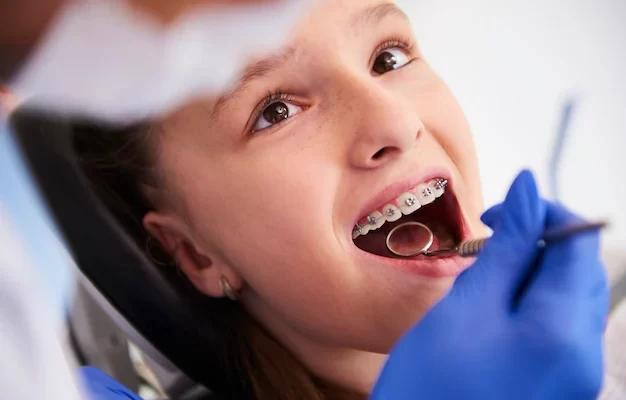Taking care of your oral hygiene is important and becomes even more crucial when you have braces. Braces play a significant role in aligning your teeth and improving your dental health. However, they also require extra attention to prevent the risks associated with poor oral hygiene.
This comprehensive guide will provide you with essential information on caring for your teeth with braces, including the importance of dental hygiene, tools for cleaning your teeth, step-by-step guides to brushing and flossing, dealing with common braces problems, and maintaining a brace-friendly diet.
Why is Dental Hygiene with Braces Important?
If you neglect your oral hygiene while wearing braces, you may face several risks. The brackets and wires of braces create tiny spaces where plaque can accumulate. If left unattended, this plaque buildup can lead to dental issues like tooth decay, gum inflammation, and bad breath. Additionally, poor oral hygiene can prolong your orthodontic treatment, as gum disease or cavities may require the removal of the braces for proper treatment.
If you’re seeking guidance on maintaining oral health during treatment, Kumra Orthodontics is an exceptional resource. As a distinguished orthodontist in Washington DC, their team emphasizes the significance of dental hygiene. It provides patients with the tools and knowledge necessary to safeguard their smiles throughout their orthodontic journey.
What are Essential Tools for Cleaning Teeth with Braces?
When it comes to cleaning your teeth with braces, using the right tools is crucial. Let’s explore some of the essential tools specifically designed for individuals with orthodontic treatment.
Traditional Toothbrush vs. Orthodontic Toothbrush
A regular toothbrush can effectively clean your teeth, but an orthodontic toothbrush is specially designed for those with braces. It features bristles in varying lengths and angles to reach the nooks and crannies around braces. Orthodontic toothbrushes also have a small, tapered brush head, making it easier to clean around brackets and wires.
The Use of Dental Floss and Floss Threaders
Flossing is crucial for maintaining optimal oral hygiene, including when you have braces. Traditional floss may be challenging to thread between the braces’ wires, which is where floss threaders come in handy. These small plastic devices enable you to navigate the floss under the wires, allowing you to clean between your teeth effectively.
The Benefits of Using a Water Flosser
A water flosser is an excellent addition to your oral hygiene routine with the braces. This particular device uses a water stream that helps remove plaque, bacteria, and food particles from hard-to-reach areas. Water flossers are gentle on the gums and can provide a more thorough clean than traditional flossing alone. Including a water flosser in your routine can significantly enhance the effectiveness of your oral care.
Step-by-Step Guide to Brushing and Flossing with Braces

Now that you have the necessary tools for cleaning your teeth with braces, let’s dive into a step-by-step guide on brushing and flossing.
Proper Brushing Techniques with Braces
When brushing your teeth with braces, it’s crucial to take the time and be thorough. First, rinse your mouth with only water so that you remove any loose debris stuck between the teeth. Then, use a toothbrush with soft bristles or an orthodontic toothbrush at an angle of 45 degrees. Thereafter, gently brush in small circular motions. Pay more attention to brushing around the brackets and wires, ensuring you clean all surfaces of the teeth. Two minutes of brushing twice a day is good maintenance.
Effective Flossing Methods for Braces
Incorporating flossing into your daily oral care routine is essential for removing plaque and food particles trapped between your teeth and braces. Start by threading the floss threader with dental floss and carefully guide it between each tooth and under the wires. Once the floss is in place, move it up and down along the sides of each tooth, ensuring you reach the gumline. Repeat this process for each tooth, using a fresh section of floss for each gap.
How to Deal with Common Braces Problems
During your orthodontic treatment, you may encounter some common problems with your braces. It’s important to know how to address these issues promptly.
Managing Discomfort and Pain from Braces
It’s not uncommon to experience discomfort or mild pain when you first get braces or after an adjustment. You can alleviate this by rinsing your mouth with warm saltwater or taking over-the-counter pain relief medication. Applying a cold compress to the outside of your mouth can also help reduce any swelling or soreness. If the pain persists or becomes severe, consult your orthodontist for further advice.
Addressing Broken or Loose Braces Components
If you notice a loose or broken bracket, wire, or any other component of your braces, contact your orthodontist immediately. Avoid trying to fix it yourself, as this could cause further damage. Your orthodontist will guide you on handling the situation until you can get professional help.
Maintaining a Brace-Friendly Diet
Your diet plays a significant role in maintaining good oral health while wearing braces. Some foods can damage or get stuck in your brackets and wires, leading to discomfort and potential complications.
Foods to Enjoy and Avoid with Braces
Stick to a soft diet and avoid hard, sticky, or crunchy foods. Enjoy nutritious options like yogurt, mashed potatoes, smoothies, and soft fruits. Stay away from chewy candies, popcorn, nuts, and hard candies that can break or dislodge your braces components. By making smart food choices, you can minimize the risk of damaging your braces and maintain a healthy smile throughout your treatment.
The Impact of Sugary and Acidic Foods on Braces
Foods high in sugar and acidity can increase the chances of tooth decay and demineralization, especially when wearing braces. Consuming excessive amounts of soda, sugary snacks, or acidic beverages can erode tooth enamel and promote plaque formation. Limit your intake of these foods and drinks, or brush your teeth immediately after consuming them to minimize their harmful effects on your dental health.
Conclusion
By following these guidelines and incorporating them into your daily routine, you can ensure proper care for your teeth with braces. Remember, maintaining good oral hygiene is essential for achieving the best possible results and maintaining your dental health throughout your orthodontic treatment. Be proactive, stay consistent, and consult your orthodontist if you have any concerns or questions along the way. With proper care and attention, you’ll soon be enjoying a beautiful, healthy smile!
Read Also:
















